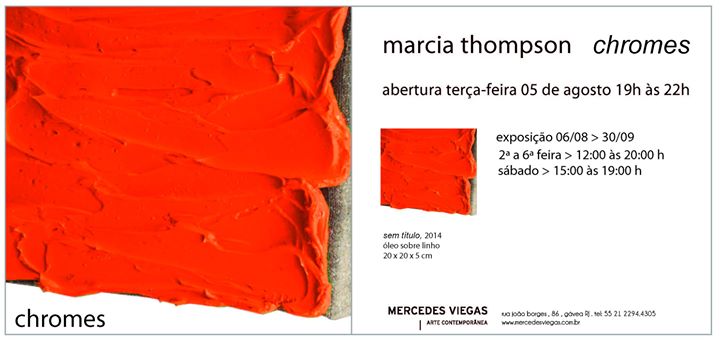Marcia Thompson







Chromes
As it has already been said, Marcia Thompson's work is affiliated with a segment of art which has its roots in the Pos-Minimalism. Eva Hesse is the best example of a representative name from this period and her work is an inspiration for the artist. If the minimal, as well as the Conceptualism, seeks for a disincarnate art, well rooted in the modern art grid; the post-minimalists, like Hesse, Serra, De Maria, will precisely present a carnality previously non-existent in the workmanship. The core of the subject leaves traces and the hand-made quality becomes evident. In Thompson’s work the modular and serialized base of Minimalism remains, but precisely to be deflected, subverted.
In "Chromes", solo show at Mercedes Viegas Gallery, paintings, drawings, objects and videos follow-up an investigation which dates back to the 90s. At the time the artist had started a research in the pictorial field, but with a completely distinctive accent other than all we had seen in the so called “revival of painting” that took place in the 80s. If then, a neoexpressionism dominates the scene and the palette was cloudy, Thompson’s steps went in the opposite direction. In electing only the white as the colour of her works, the artist has taken the first step in her method where less is more. What we see today is a continuation of those times, the difference being that the presence of the colour has been truly embraced. The choice of using exclusively white relates to Piero Manzoni’s “Achromes”. This decision assisted the artist in one of the central points of her poetic; that is, to establish a zero-degree of a painting, where we come upon the total lack of narrative and what remains is nothing more than a DNA of the painting. One should bare in mind that there is a subtle boundary between the disincarnate art of the minimal and the one that adds temperature, sensuality, carnal traces to the work of art. The blocks of oil paint in acrylic boxes, the different chunks of colour on the raw canvas, the tortuous dots that appear when the paint passes through the gaps of the surface, the ruled paper cautiously subverted, all these, added to a powerful use of colour - oranges, blues, reds, yellows - create tension between the modular, the serialized experience and the one of the difference; between the distance of abstraction and the proximity of the paint that turns into skin, becomes flesh.
Each of those works is unique. They all resemble, but they are never the same. If there is a geometry, it is a sensitive one; not analytic, distant. The works make use of the grid codes, the modular codes; to then create a twist that points out to a universe closer to life, with its unavoidable dose of chance and unpredictability. Using an unsuspected method, that makes use of repetition to establish the difference, Thompson asks for attentive eyes to perceive the singularities in the midst of what always seems the same. True to undertones, and not to the uproar that takes over the world out there, these pieces make the silence an expressive part of the artwork. As in the gaps of a music composition or the spaces between the lines of a poem, it is necessary to hear the intervals, read the pauses so that we can understand the sense of the whole. It is precisely in the most delicate spaces between lines that reside the captivating balance between refinement and carnality stressed powerfully in "Chromes", and reveals the core of Marcia Thompson’s work over the last 20 years.
by Luisa Duarte
Rio de Janeiro, 2014